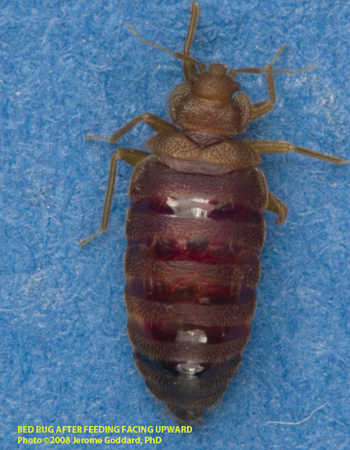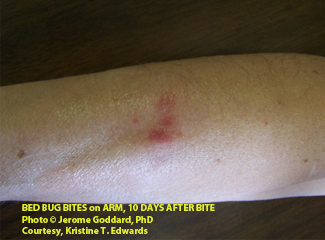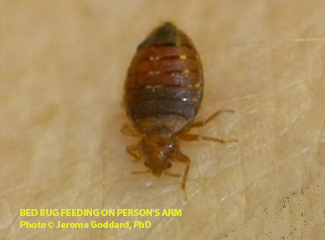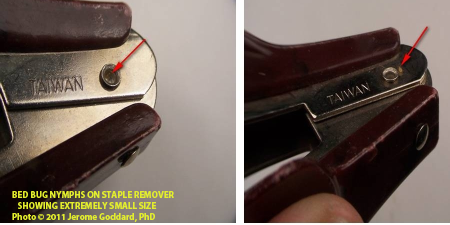- Clinical Technology
- Adult Immunization
- Hepatology
- Pediatric Immunization
- Screening
- Psychiatry
- Allergy
- Women's Health
- Cardiology
- Pediatrics
- Dermatology
- Endocrinology
- Pain Management
- Gastroenterology
- Infectious Disease
- Obesity Medicine
- Rheumatology
- Nephrology
- Neurology
- Pulmonology
Bed Bug Bites: Everything You Need to Know-But Were Afraid to Ask
Here: a review of the potential health effects of bed bugs, diagnosis and treatment, and comments about future directions in bed bug control and public health efforts to manage the pest.

Bed bugs are in the insect family Cimicidae. There are at least 91 species worldwide, but most occur only on bats and birds.1,2 However, the common bed bug, Cimex lectularius (Figure), has adapted to human feeding and has been a household associate of humans for thousands of years. With the advent of DDT and other powerful pesticides, bed bugs nearly disappeared in developing countries until recently, where, in the past 2 decades or so, they have been making a progressively rapid comeback. In many areas, they are now the number one urban pest.3-6
Health and medical effects from bed bugs include:
• Emotional and psychological effects
• Nuisance biting
• Allergic reactions to their bites
• Anemia when infestations are enormous
• Potential disease transmission

Here I review each of these potential health effects, discuss diagnosis and treatment, and offer comments about future directions in bed bug control and public health efforts to manage the pest.
Health effects
The primary negative health effects from bed bug biting are not disease transmission, but instead, emotional trauma and the itching and inflammation (nuisance) associated with their bites. There is some evidence that bed bug attacks lead to insomnia, emotional distress, and anxiety.7-9 Limited evidence and anecdotal reports indicate that bed bug attacks may cause more serious psychological effects similar to posttraumatic stress disorder.10
As for nuisance biting, the most common cutaneous reactions are small, pruritic maculopapular, erythematous lesions at bed bug feeding sites, one per insect. These usually begin itching with 72 hours and, if not scratched extensively, resolve after a week or so.11-13 For those individuals who experience repeated bites, the time to onset of itching generally decreases and the intensity of the bite reaction increases.14-16

Some people experience more complex, even serious, cutaneous reactions. Reports of these have included pruritic wheals (local urticaria) around a central punctum, papular urticaria, and diffuse urticaria at bite sites usually noted on arising in the morning.17-21 Bullous lesions, resembling blood blisters, may occur on subsequent biting events days later.22-26
As mentioned, the timing of cutaneous reactions to bed bugs may change with subsequent exposures and appears to reflect host immunological responses to bed bug salivary proteins.12,22,27-31 Reinhardt and colleagues32 reported that with repeated exposure, the latency between bite and skin reaction decreased from 10 days to a few seconds. Interestingly, people who experience subsequent bed bug biting sometimes have old lesions that “re-inflame” on new biting anywhere on the body. This “re-lighting-up” phenomenon at sites of previous lesions has been anecdotally reported previously, but is poorly understood.33,34

Presumably, it results from antigens that reside at the bite site for an extended period, and from these antigens responding to inflammatory mediators circulating to new bites.
Although rare, there are a few reports of systemic allergic reactions from bed bug bites, including asthma, generalized urticaria, and anaphylaxis.24,35-37 One patient awakened during the night at a hotel with severe itching and urticaria on his arm and neck and bed bugs were found in his room.38 Angioedema and hypotension developed, and the man was hospitalized and had transient anterolateral ischemia on an ECG. Eight months later, after an experimental bed bug bite, a wheal developed at the bite site along with generalized itching that required epinephrine administration to resolve his symptoms. Evaluation of another man with asthma revealed bed bugs in his bedding, and an intradermal allergy skin test with an extract of bed bugs was positive.37 Interestingly, after his bedding was changed, the asthma attacks ceased.

In heavy infestations, blood loss from bed bug biting can be significant enough to cause anemia in humans and animals. We have investigated poultry houses infested with bed bugs and found some of the birds to be anemic.39 As for humans, a patient in Canada repeatedly presented to the hospital with anemia, and after a few days of treatment each time, was sent home.40 Eventually, an inquisitive physician from the hospital made a home visit and found thousands of bed bugs in the man’s mattress and bedding.40 The patient reported no bite marks; some people do not react.
Bed bugs have been suspected in the transmission of more than 40 disease organisms, such as those causing anthrax, plague, hepatitis, and typhus,41 and have been found naturally infected with many of these disease agents (especially hepatitis B virus).42-46 At this time, however, bed bugs have never been proved to biologically transmit even one human pathogen.47 A recent report of bed bugs containing methicillin-resistant Staphylococcus aureus created quite a stir in the news media, but again, biological transmission (or even mechanical transmission) was not proved in that report.48 The fact that blood-sucking insects may pick up disease agents while feeding is not surprising; however, the ability to subsequently transmit those agents is a completely different story.
Diagnosis and treatment
Bed bugs should be suspected in any case of mysterious biting that occurs primarily at night, and/or when itchy erythematous rashes are noted on rising from sleep, no matter the time of day. Although not always the case, bed bug bites are predominant on the head, neck, and upper body, and they may appear in a line.
Treatment of cutaneous reactions is usually symptomatic and not evidence-based. Bite sites should be washed with soap and water, and if lesions are pruritic, topical application of over-the-counter or prescription antipruritic agents (paroxime, doxepin) or intermediate-potency corticosteroids (triamcinolone) may be helpful. Sites that appear to be secondarily infected may benefit from topical mupirocin or systemic antibiotics as appropriate.
Systemic allergic reactions to bed bug bites should be treated as any other insect-induced anaphylaxis.27,38,49 That treatment may include intramuscular epinephrine first, followed by antihistamines and corticosteroids when appropriate. Patients with previous generalized reactions should be referred to an allergist and also taught to use an epinephrine auto-injector device, which should be kept readily available.
Practice message and future directions
For most physicians, the primary issues related to bed bugs are learning to recognize possible bite reactions (although there are no aspects of bed bug bites that are pathognomonic), treating symptomatically, and perhaps directing patients to appropriate pest control information and/or pest management professionals.
Unfortunately, bed bug control is not possible using over-the-counter remedies and insecticides, and professional help is necessary. Eradication of the pests involves intensive inspection and treatment, using a variety of pest control techniques (including pesticides). Bed bug infestations are quickly becoming a public health or “social justice” issue, with the poor and underserved populations disproportionately affected. Physicians may very well play an important role by treating affected patients and pointing them to the right governmental agency for help and intervention.
References:
1. Reinhardt K, Siva-Jothy MT. Biology of the bed bugs. Ann Rev Entomol. 2007;52:351-374.
2. Usinger RL. Monograph of Cimicidae. College Park, MD: Entomological Society of America, Thomas Say Foundation; 1966:17.
3. Potter MF. The perfect storm: an extension view on bed bugs. Am Entomol. 2006;52:102-104.
4. Doggett S, Russell RC. The resurgence of bed bugs, Cimex spp, in Australia: experiences from down under. Proceedings of the 6th International Conference on Urban Pests; July 13-16, 2008; Budapest, Hungary.
5. Potter MF. The business of bed bugs: Pest Management Professional Magazine. January 2008:24-29.
6. Potter MF, Rosenberg B, Henriksen M. Bugs without borders: defining the global bed bug resurgence. Pest World. 2010:Sept/Oct:8-20.
7. Benac N. Bed bug bites becoming bigger battle. CMAJ. 2010;182:1606.
8. Doggett S, Dwyer DE, Penas PF, Russell RC. Bed bugs: clinical relevance and control options. Clin Microbiol Rev. 2012;25:164-192.
9. Potter MF, Haynes KF, Deutsch M, et al. The senstivity spectrum: human reactions to bed bug bites. Pest Control Technology Magazine. Feb 2010:70-75.
10. Goddard J, de Shazo RD. Psychological effects of bed bug attacks (Cimex lectularius L). Am J Med. 2012;125:101-103.
11. Kemper H. Die bettwanze und ihre bekampfung. Schriften uber Hygienische Zoologie Z. Kleintierk. Pelztierk. 1936;12:1-107.
12. Ryckman RE. Dermatological reactions to the bites of four species of triatominae (hemiptera: reduviidae) and Cimex lectularius L. (hemiptera: cimicidae). Bull Soc Vector Ecol. 1985;10:122-125.
13. Masetti M, Bruschi F. Bedbug infestations recorded in Central Italy. Parasitol Int Mar. 2007;56:81-83.
14. Liebold K, Schliemann-Willers S, Wollina U. Disseminated bullous eruption with systemic reaction caused by Cimex lectularius. J Eur Acad Dermatol Venereol. 2003;17:461-463.
15. Bartley JD, Harlan HJ. Bed bug infestation: its control and management. Mil Med. 1974;139:884-886.
16. Cestari TF, Martignago BF. Scabies, pediculosis, and stinkbugs: uncommon presentations. Clin Dermatol. 2005;23:545-554.
17. Alexander JO. Arthropods and Human Skin. Berlin: Springer-Verlag; 1984.
18. Brasch J, Schwarz T. 26-year-old male with urticarial papules. J Dtsch Dermatol Ges. 2006;4:1077-1079.
19. Gbakima AA, Terry BC, Kanja F, et al. High prevalence of bedbugs Cimex hemipterus and Cimex lectularis in camps for internally displaced persons in Freetown, Sierra Leone: a pilot humanitarian investigation. West Afr J Med. 2002;21:268-271.
20. Honig PJ. Arthropod bites, stings, and infestations: their prevention and treatment. Pediatr Dermatol. 1986;3:189-197.
21. Rook AJ. Papular urticaria. Pediatr Clin North Am. 1961;8:817-820.
22. Cooper DL. Can bedbug bites cause bullous erythema? J Am Med Assoc. 1948;138:1206.
23. Hamburger F, Dietrich A. Lichen urticatus exogenes. Acta Paediatr. 1937;22:420.
24. Kemper H. Beobachtungen ueber den Stech-und Saugakt der Bettwanze und seine Wirkung auf die menschliche Haut. Zeitschr f Desinfekt. 1929;21:61-65.
25. Kinnear J. Epidemic of bullous erythema on legs due to bed-bug. Lancet. 1948;255:55.
26. Patton WS, Evans A. Insects, Ticks, and Venomous Animals of Medical and Veterinary Importance, Part I. Croydon, UK: HR Grubb Ltd; 1929.
27. Churchill TP. Urticaria due to bed bug bites. J Am Med Assoc. 1930;95:1975-1976.
28. Elston DM, Stockwell S. What’s eating you? Bed bugs. Cutis. 2000;65:262-264.
29. Hect O. Die hautreaktionen auf insektenstiche als allergische erscheinungen. Zool Anz. 1930;87:94, 145, 231.
30. Ryckman RE. Host reactions to bug bites (hemiptera, homoptera): a literature review and annotated bibliography, Part I. California Vect Views. 1979;26:1-24.
31. Ryckman RE, Bently DG. Host reactions to bug bites: a literature review and annotated bibliography, Part II. California Vect Views. 1979;26:25-49.
32. Reinhardt K, Kempke RA, Naylor RA, Siva-Jothy MT. Sensitivity to bites by the bedbug, Cimex lectularius. Med Vet Entomol. 2009;23:163-166.
33. Goddard J, Edwards KT, de Shazo RD. Observations on development of cutaneous lesions from bites by the common bed bug, Cimex lectularius L. Midsouth Entomol. 2011;4:49-52.
34. McKiel JA, West AS. Nature and causation of insect bite reactions. Pediatr Clin North Am. 1961;8:795-814.
35. Bircher AJ. Systemic immediate allergic reactions to arthropod stings and bites. Dermatology. 2005;210:119-127.
36. Jimenez-Diaz C, Cuenca BS. Asthma produced by susceptibility to unusual allergens. J Allergy. 1935;6:397-403.
37. Sternberg L. A case for asthma caused by the Cimex lectularius.Med J Rec. 1929;129:622.
38. Parsons DJ. Bed bug bite anaphylaxis misinterpreted as coronary occlusion. Ohio State Med J. 1955;51:669.
39. Cater J, Hubbard SA, Magee D, et al. Severe infestation of bed bugs in a broiler-breeder house. J Am Vet Med Assoc. In press.
40. Pritchard MJ, Hwang SW. Severe anemia from bed bugs. CMAJ. 2009;181:287-288.
41. Burton GJ. Bed bugs in relation to transmission of human diseases. Public Health Rep. 1963;78:513-524.
42. Delaunay P, Blanc V, Del Giudice P, et al. Bedbugs and infectious diseases. Clin Infect Dis. 2011;52:200-210.
43. El-Masry SA, Kotkat AM. Hepatitis B surface antigen in Cimex lectularius. J Egyptian Public Health Assoc. 1990;55:230-236.
44. Jupp PG, Lyons SF. Experimental assessment of bedbugs and mosquitoes as vectors of human immunodeficiency virus. AIDS. 1987;1:171-174.
45. Jupp PG, McElligott SE. Transmission experiments with hepatitis B surface antigen and the common bed bug. S Afr Med J. 1979;56:54-57.
46. Jupp PG, Prozesky OW, McElligott SE, Van Wyk LA. Infection of the common bed bug with hepatitis B virus in South Africa. S Afr Med J. 1978;53:598-600.
47. Goddard J, de Shazo RD. Bed bugs (Cimex lectularius) and clinical consequences of their bites. JAMA. 2009;301:1358-1366.
48. Lowe CF, Romney MG. Bedbugs as vectors for drug-resistant bacteria. Emerg Infect Dis. 2011;17:1132-1134.
49. Oswalt ML, Kemp SF. Anaphylaxis: office management and prevention. Immunol Allergy Clin North Am. 2007;27:177-191.
FDA Approves Guselkumab for Pediatric Plaque Psoriasis and Active Psoriatic Arthritis
September 30th 2025The FDA has approved guselkumab for children aged 6 years and older with moderate to severe plaque psoriasis or active psoriatic arthritis, making it the first IL-23 inhibitor authorized for pediatric use.
